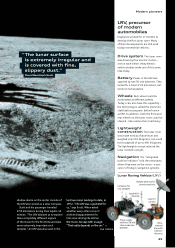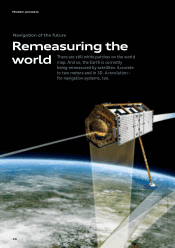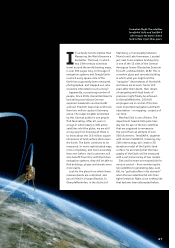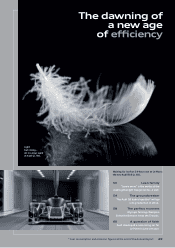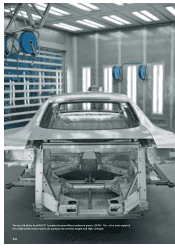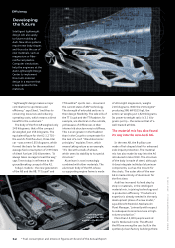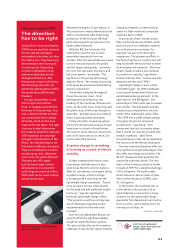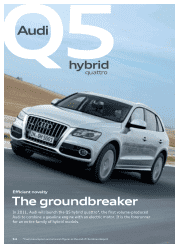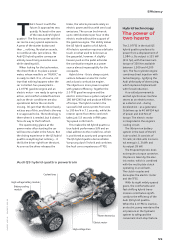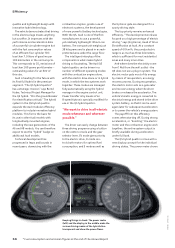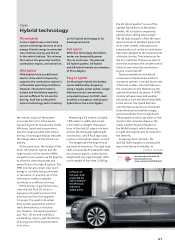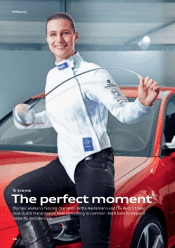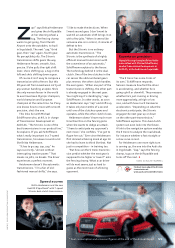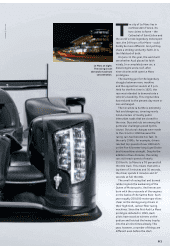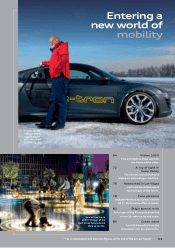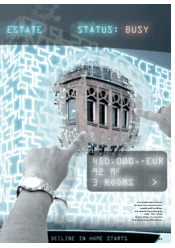Audi 2010 Annual Report Download - page 57
Download and view the complete annual report
Please find page 57 of the 2010 Audi annual report below. You can navigate through the pages in the report by either clicking on the pages listed below, or by using the keyword search tool below to find specific information within the annual report.
55
T
hat’s how it is with the
future: It approaches very
quietly. At least in the case
of the new Audi Q5 hybrid
quattro*. The fi rst encounter with the
car can be a very special experience.
A press of the starter button and
then ... nothing. No starter sounds,
no rumble at idle. Just silence. The
Audi Q5 hybrid quattro conveys an
entirely new driving sensation even
while standing still.
When looking for the tachometer,
the driver fi nds in its place a power
meter, whose needle is on “READY,” as
in ready to start. It is, of course, not
true that nothing happens when the
car is started. Two powerplants –
a 2.0 TFSI gasoline engine and an
electric motor – are ready to spring into
action, and comfort-related functions
such as the air conditioner are also
operational before the car starts
moving. It’s just that the driver barely
notices any of this, and that is the way
it is supposed to be. The technology is
there when it is needed, but it doesn’t
force its way to the forefront.
The questioning glance at the
power meter after starting the car
will become a habit in the future. But
the driving experience in the Q5 hybrid
quattro is anything but ordinary – it
thrills the driver right from the start.
As soon as the driver releases the
brake, the vehicle proceeds solely on
electric power and thus with zero local
emissions. The car can be driven at
up to 100 kilometers per hour in this
electric mode without the support of
the gasoline engine. This ability makes
the Q5 hybrid quattro a full hybrid.
All-electric operation requires a delicate
touch on what used to be known as
the gas pedal, however. A slightly
heavier push on the pedal activates
the combustion engine as a power
source almost imperceptibly for the
occupants.
Hybrid drive – this is always a joint
venture between an electric motor
and a classic combustion engine.
The objective is more power coupled
with greater effi ciency. Together the
2.0 TFSI gasoline engine and the
electric motor have a system output of
180 kW (245 hp) and produce 480 Nm
of torque. The hybrid model in the
successful Q5 series sprints from zero
to 100 km/h in 7.1 seconds, while the
interim sprint from 80 to 120 km/h
takes just 5.9 seconds in fi fth gear.
Top speed is 222 km/h.
This makes the Q5 hybrid quattro a
true hybrid performance SUV and an
ideal addition to the model line, which
is positioned as sporty and progressive.
The Q5 hybrid quattro demonstrates
Vorsprung durch Technik and combines
the Audi core competences of TFSI,
Effi ciency
The power of
two hearts
Hybrid technology
High-voltage battery module
Coolant lines
High-voltage lines
Electric motor
Power electronics
The 2.0 TFSI in the Audi Q5
hybrid quattro produces its
power from a displacement of
1,984 cc. Its output is 155 kW
(211 hp), with the maximum
torque of 350 Nm available
between 1,500 and 4,200
rpm. The four-cylinder engine
combines direct injection with
turbocharging – typifying the
Audi philosophy of downsizing,
which replaces displacement
with forced induction.
A so-called permanently
excited synchronous machine
serves as an electric motor,
as a starter and – during
deceleration – as a generator.
It delivers up to 40 kW (54 hp)
of power and 210 Nm of
torque. The electric motor
is integrated in the engine’s
cooling circuit.
The lithium-ion battery
system in the back of the Q5
is air-cooled. It consists of
72 cells; at 266 volts its nomi-
nal energy is 1.3 kWh and
its output 39 kW.
The 8-speed tiptronic does
not require a torque converter.
Its place is taken by the elec-
tric motor, which is combined
with the multi-plate clutch
operating in an oil bath.
The clutch couples and
decouples the electric motor
and the TFSI.
With its eight widely spaced
gears, the comfortable and
fast-shifting hybrid trans-
mission contributes signifi -
cantly to the effi ciency of the
Audi Q5 hybrid quattro.
When the 2.0 TFSI is inactive,
an electric pump maintains the
oil pressure in the hydraulic
system to safeguard the
convenient start-stop feature.
Audi Q5 hybrid quattro powertrain
PHOTO | AUDI AG GRAPHIC | AUDI AG
Battery cooling
module


